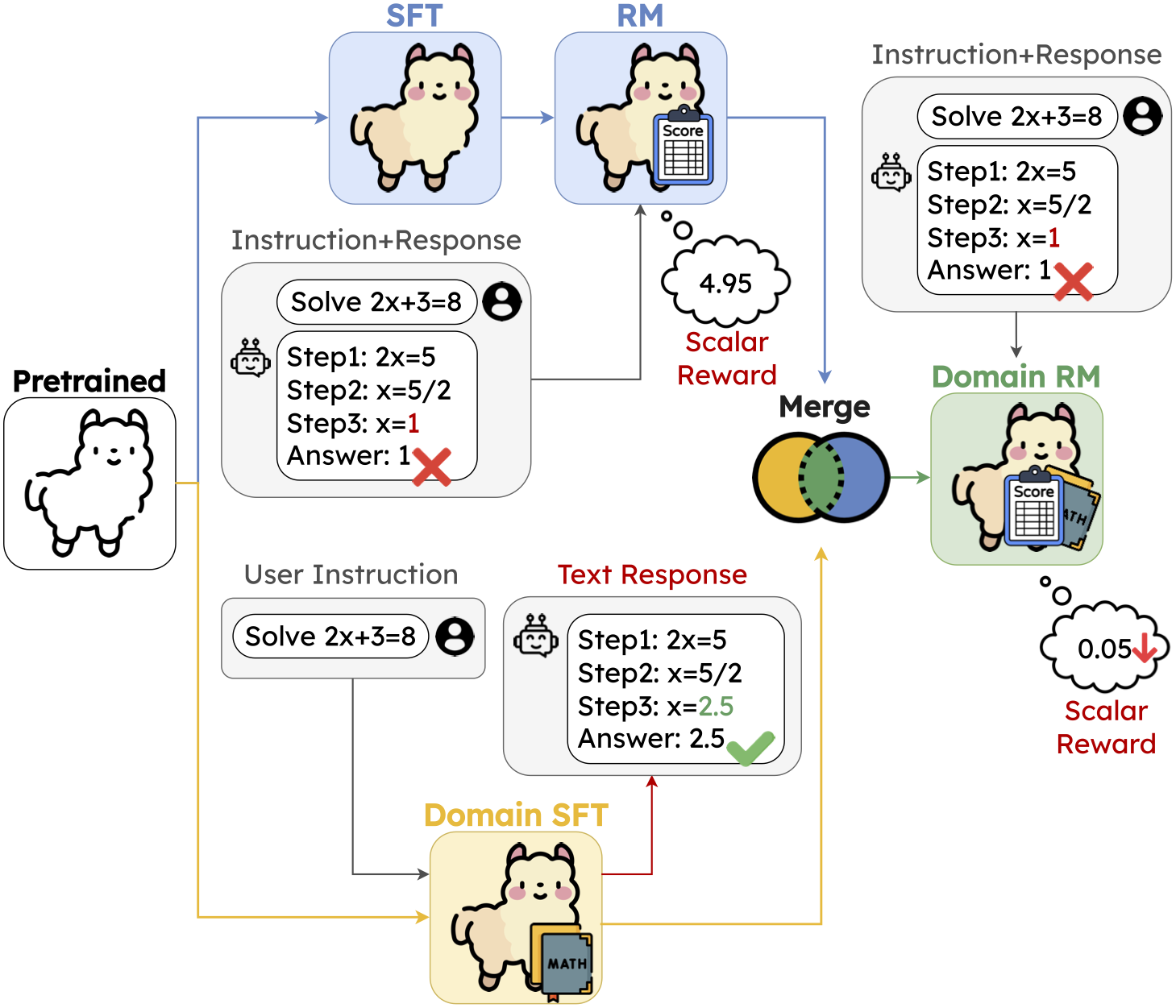Overview of our DogeRM framework. We merge the general RM with a domain-specific LM to create the domain-specific RM. All icons used in this figure are sourced from https://www.flaticon.com/
- [2024.10.08] 🚧🚧🚧 Currently we are trying to integrating features such as system prompt into reward-bench. As a result, the evaluations on reward-bench are temporarily unavailable. 🚧🚧🚧
- [2024.10.06] We release our experimental codes and the model collections on 🤗huggingface.
- [2024.09.20]: 🎉🎉🎉 Our paper is accepted at EMNLP 2024 main conference (short paper). 🎉🎉🎉
Please clone our repo first:
git clone https://github.com/MiuLab/DogeRM.gitAdditionally, install the following repo for evaluation:
And clone Auto-J Eval Repo for accessing Auto-J Eval pairwise testing data, which can be found at data/testing/testdata_pairwise.jsonl.
After install conda:
cd DogeRM/
conda create -n {your_env_name} -f environment.yaml
conda activate {your_env_name}🚧🚧🚧
Note: We are in the process of integrating new features, including the system prompt functionality, into reward-bench. During this update, evaluations on reward-bench are temporarily unavailable. Thank you for your patience.
🚧🚧🚧
We include our modified RewardBench here, where the modification includes:
- use system prompt for our LLaMA-2 based RM, which is not included in the original implementation
- Load RM with
float16precision. - print the result of each subset to
stdout - report the result to
wandb
Since the python version required by reward-bench is different from what we used in RM training, so we create a separate environment for reward-bench.
You should create a new environment with python>=3.10 first:
conda create -n {env_name_for_reward_bench} python=3.10 # or later version of python
conda activate {env_name_for_reward_bench}
# install the required packages
cd reward-bench
pip install -e .Then, run the following code, which contains the whole pipeline for merging and evaluation:
reward_model="miulab/llama2-7b-ultrafeedback-rm"
langauge_model="miulab/llama2-7b-magicoder-evol" # or other langauge models
merged_model_output_path="../models/merged_model"
proj_name="{your_wandb_project_name}"
run_name_prefix="{wandb_run_name_prefix}"
# the run name on wandb will be $run_name_prefix-seq-$seq_ratio-lm-$lm_ratio
# where $seq_ratio is the weight for RM parameter
# and $lm_ratio is the weight for language model parameter
# in the merging process
bash run_merge.sh \
$reward_model \
$language_model \
$merged_model_output_path \
$project_name The evaluation result can be found at wandb.
For Auto-J Eval, you can run the whole pipeline, including merging and evaluation, using:
reward_model="miulab/llama2-7b-ultrafeedback-rm"
langauge_model="miulab/llama2-7b-magicoder-evol-instruct"
merged_model_output_path="../models/merged_model"
autoj_data_path="{path_to_autoj_pairwise_testing_data}"
cd scripts/
bash run_autoj_merge.sh \
$reward_model \
$langauge_model \
$merged_model_output_path \
$autoj_data_pathThe evaluation result will be printed to stdout.
For GSM8K, you can run the whole pipeline, including merging and evaluation, using:
reward_model="miulab/llama2-7b-ultrafeedback-rm"
langauge_model="miulab/llama2-7b-magicoder-evol-instruct"
merged_model_output_path="../models/merged_model"
bon_output_root="../bon_output/llama2/mbpp"
lm_output_file_name="llama2-chat.json"
log_file_name="log_file.txt"
rm_output_file_prefix="ultrafeedback-code"
cd scripts/
bash merge_gsm8k_bon.sh \
$reward_model \
$langauge_model \
$merged_model_output_path \
$bon_output_root \
$lm_output_file_name \
$log_file_name \
$rm_output_file_prefixThe evaluation results can be found at the DogeRM/bon_output/llama2/gsm8k/log_file/{log_file_name}.
For MBPP, you can run the whole pipeline, including merging and evaluation, using:
reward_model="miulab/llama2-7b-ultrafeedback-rm"
langauge_model="miulab/llama2-7b-magicoder-evol-instruct"
merged_model_output_path="../models/merged_model"
bon_output_root="../bon_output/llama2/mbpp"
lm_output_file_name="llama2-chat.json"
log_file_name="log_file.txt"
rm_output_file_prefix="ultrafeedback-code"
path_to_bigcode_eval="{path_to_bigcocde_evaluation_harness_repo}"
cd scripts/
bash merge_mbpp_bon.sh \
$reward_model \
$language_model \
$merged_model_output_path \
$bon_output_root \
$lm_output_file_name \
$log_file_name \
$rm_output_file_prefix \
$path_to_bigcode_evalThe evaluation results can be found at DogeRM/bon_output/execution_result/.
deepspeed --num_gpus {num_gpus_on_your_device} src/train_rm.py \
--model_name_or_path miulab/llama2-7b-alpaca-sft-10k \
--output_dir models/llama2-7b-ultrafeedback \
--report_to wandb \
--run_name {wabdb_run_name} \
--per_device_train_batch_size 4 \
--num_train_epochs 1 \
--fp16 True \
--gradient_accumulation_steps 1 \
--torch_dtype auto \
--learning_rate 1e-5 \
--warmup_ratio 0.05 \
--remove_unused_columns False \
--optim adamw_torch \
--logging_first_step True \
--logging_steps 10 \
--evaluation_strategy steps \
--eval_steps 0.1 \
--save_strategy steps \
--save_steps 100000000 \
--save_total_limit 1 \
--max_length 2048 \
--test_size 0.1 \
--dataset_shuffle_seed 42 \
--dataset_name argilla/ultrafeedback-binarized-preferences-cleaned \
--dataset_config_path config/dataset.yaml \
--gradient_checkpointing True \
--deepspeed config/ds_config.jsonpython src/merge_linear.py \
--seq_model {your_reward_mdoel} \
--seq_weight {weight_for_reward_model_parameters} \
--lm_model {your_langauge_model} \
--lm_weight {weight_for_language_model_parameters} \
--output_path {output_path_for_merged_model}If you find our code and models useful, please cite our paper using the following bibtex:
@article{lin2024dogerm,
title={DogeRM: Equipping Reward Models with Domain Knowledge through Model Merging},
author={Lin, Tzu-Han and Li, Chen-An and Lee, Hung-yi and Chen, Yun-Nung},
journal={arXiv preprint arXiv:2407.01470},
year={2024}
}We thank the reviewers for their insightful comments. This work was financially supported by the National Science and Technology Council (NSTC) in Taiwan, under Grants 111-2222-E-002-013-MY3 and 112-2223-E002-012-MY5. We thank to National Center for High-performance Computing (NCHC) of National Applied Research Laboratories (NARLabs) in Taiwan for providing computational and storage resources. We are also grateful to Yen-Ting Lin, Wei-Lin Chen, Chao-Wei Huang and Wan-Xuan Zhou from National Taiwan University for their insightful discussions and valuable advice on the overview figure.


